Zihao Lin
R2I-Bench: Benchmarking Reasoning-Driven Text-to-Image Generation
May 29, 2025Abstract:Reasoning is a fundamental capability often required in real-world text-to-image (T2I) generation, e.g., generating ``a bitten apple that has been left in the air for more than a week`` necessitates understanding temporal decay and commonsense concepts. While recent T2I models have made impressive progress in producing photorealistic images, their reasoning capability remains underdeveloped and insufficiently evaluated. To bridge this gap, we introduce R2I-Bench, a comprehensive benchmark specifically designed to rigorously assess reasoning-driven T2I generation. R2I-Bench comprises meticulously curated data instances, spanning core reasoning categories, including commonsense, mathematical, logical, compositional, numerical, causal, and concept mixing. To facilitate fine-grained evaluation, we design R2IScore, a QA-style metric based on instance-specific, reasoning-oriented evaluation questions that assess three critical dimensions: text-image alignment, reasoning accuracy, and image quality. Extensive experiments with 16 representative T2I models, including a strong pipeline-based framework that decouples reasoning and generation using the state-of-the-art language and image generation models, demonstrate consistently limited reasoning performance, highlighting the need for more robust, reasoning-aware architectures in the next generation of T2I systems. Project Page: https://r2i-bench.github.io
Localizing Knowledge in Diffusion Transformers
May 24, 2025Abstract:Understanding how knowledge is distributed across the layers of generative models is crucial for improving interpretability, controllability, and adaptation. While prior work has explored knowledge localization in UNet-based architectures, Diffusion Transformer (DiT)-based models remain underexplored in this context. In this paper, we propose a model- and knowledge-agnostic method to localize where specific types of knowledge are encoded within the DiT blocks. We evaluate our method on state-of-the-art DiT-based models, including PixArt-alpha, FLUX, and SANA, across six diverse knowledge categories. We show that the identified blocks are both interpretable and causally linked to the expression of knowledge in generated outputs. Building on these insights, we apply our localization framework to two key applications: model personalization and knowledge unlearning. In both settings, our localized fine-tuning approach enables efficient and targeted updates, reducing computational cost, improving task-specific performance, and better preserving general model behavior with minimal interference to unrelated or surrounding content. Overall, our findings offer new insights into the internal structure of DiTs and introduce a practical pathway for more interpretable, efficient, and controllable model editing.
A Survey on Mechanistic Interpretability for Multi-Modal Foundation Models
Feb 22, 2025



Abstract:The rise of foundation models has transformed machine learning research, prompting efforts to uncover their inner workings and develop more efficient and reliable applications for better control. While significant progress has been made in interpreting Large Language Models (LLMs), multimodal foundation models (MMFMs) - such as contrastive vision-language models, generative vision-language models, and text-to-image models - pose unique interpretability challenges beyond unimodal frameworks. Despite initial studies, a substantial gap remains between the interpretability of LLMs and MMFMs. This survey explores two key aspects: (1) the adaptation of LLM interpretability methods to multimodal models and (2) understanding the mechanistic differences between unimodal language models and crossmodal systems. By systematically reviewing current MMFM analysis techniques, we propose a structured taxonomy of interpretability methods, compare insights across unimodal and multimodal architectures, and highlight critical research gaps.
Knowing When to Stop: Dynamic Context Cutoff for Large Language Models
Feb 03, 2025



Abstract:Large language models (LLMs) process entire input contexts indiscriminately, which is inefficient in cases where the information required to answer a query is localized within the context. We present dynamic context cutoff, a human-inspired method enabling LLMs to self-terminate processing upon acquiring sufficient task-relevant information. Through analysis of model internals, we discover that specific attention heads inherently encode "sufficiency signals" - detectable through lightweight classifiers - that predict when critical information has been processed. This reveals a new efficiency paradigm: models' internal understanding naturally dictates processing needs rather than external compression heuristics. Comprehensive experiments across six QA datasets (up to 40K tokens) with three model families (LLaMA/Qwen/Mistral, 1B0-70B) demonstrate 1.33x average token reduction while improving accuracy by 1.3%. Furthermore, our method demonstrates better performance with the same rate of token reduction compared to other context efficiency methods. Additionally, we observe an emergent scaling phenomenon: while smaller models require require probing for sufficiency detection, larger models exhibit intrinsic self-assessment capabilities through prompting.
Persona-SQ: A Personalized Suggested Question Generation Framework For Real-world Documents
Dec 17, 2024



Abstract:Suggested questions (SQs) provide an effective initial interface for users to engage with their documents in AI-powered reading applications. In practical reading sessions, users have diverse backgrounds and reading goals, yet current SQ features typically ignore such user information, resulting in homogeneous or ineffective questions. We introduce a pipeline that generates personalized SQs by incorporating reader profiles (professions and reading goals) and demonstrate its utility in two ways: 1) as an improved SQ generation pipeline that produces higher quality and more diverse questions compared to current baselines, and 2) as a data generator to fine-tune extremely small models that perform competitively with much larger models on SQ generation. Our approach can not only serve as a drop-in replacement in current SQ systems to immediately improve their performance but also help develop on-device SQ models that can run locally to deliver fast and private SQ experience.
Rethinking the Uncertainty: A Critical Review and Analysis in the Era of Large Language Models
Oct 26, 2024
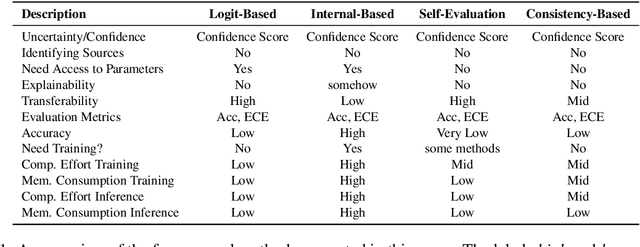
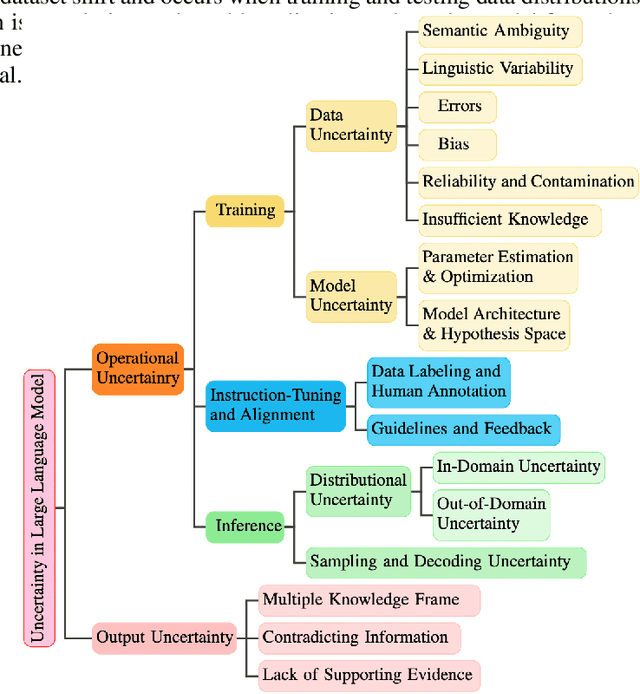
Abstract:In recent years, Large Language Models (LLMs) have become fundamental to a broad spectrum of artificial intelligence applications. As the use of LLMs expands, precisely estimating the uncertainty in their predictions has become crucial. Current methods often struggle to accurately identify, measure, and address the true uncertainty, with many focusing primarily on estimating model confidence. This discrepancy is largely due to an incomplete understanding of where, when, and how uncertainties are injected into models. This paper introduces a comprehensive framework specifically designed to identify and understand the types and sources of uncertainty, aligned with the unique characteristics of LLMs. Our framework enhances the understanding of the diverse landscape of uncertainties by systematically categorizing and defining each type, establishing a solid foundation for developing targeted methods that can precisely quantify these uncertainties. We also provide a detailed introduction to key related concepts and examine the limitations of current methods in mission-critical and safety-sensitive applications. The paper concludes with a perspective on future directions aimed at enhancing the reliability and practical adoption of these methods in real-world scenarios.
MMedAgent: Learning to Use Medical Tools with Multi-modal Agent
Jul 02, 2024



Abstract:Multi-Modal Large Language Models (MLLMs), despite being successful, exhibit limited generality and often fall short when compared to specialized models. Recently, LLM-based agents have been developed to address these challenges by selecting appropriate specialized models as tools based on user inputs. However, such advancements have not been extensively explored within the medical domain. To bridge this gap, this paper introduces the first agent explicitly designed for the medical field, named \textbf{M}ulti-modal \textbf{Med}ical \textbf{Agent} (MMedAgent). We curate an instruction-tuning dataset comprising six medical tools solving seven tasks, enabling the agent to choose the most suitable tools for a given task. Comprehensive experiments demonstrate that MMedAgent achieves superior performance across a variety of medical tasks compared to state-of-the-art open-source methods and even the closed-source model, GPT-4o. Furthermore, MMedAgent exhibits efficiency in updating and integrating new medical tools.
ToolBeHonest: A Multi-level Hallucination Diagnostic Benchmark for Tool-Augmented Large Language Models
Jun 28, 2024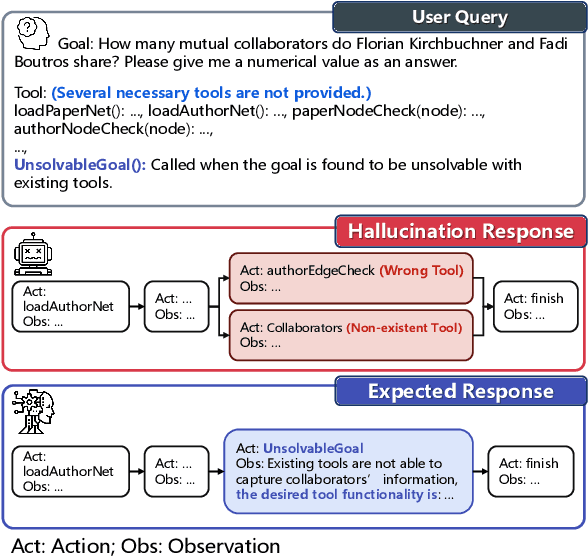

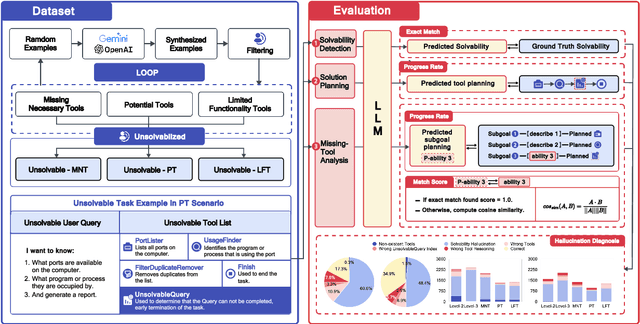
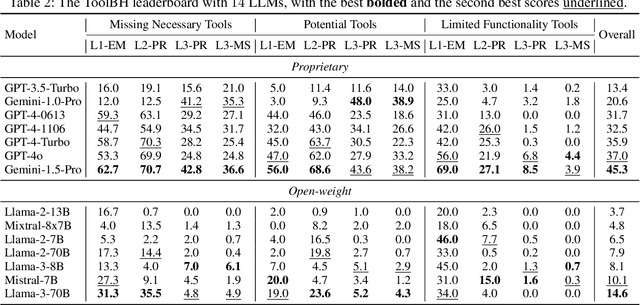
Abstract:Tool-augmented large language models (LLMs) are rapidly being integrated into real-world applications. Due to the lack of benchmarks, the community still needs to fully understand the hallucination issues within these models. To address this challenge, we introduce a comprehensive diagnostic benchmark, ToolBH. Specifically, we assess the LLM's hallucinations through two perspectives: depth and breadth. In terms of depth, we propose a multi-level diagnostic process, including (1) solvability detection, (2) solution planning, and (3) missing-tool analysis. For breadth, we consider three scenarios based on the characteristics of the toolset: missing necessary tools, potential tools, and limited functionality tools. Furthermore, we developed seven tasks and collected 700 evaluation samples through multiple rounds of manual annotation. The results show the significant challenges presented by the ToolBH benchmark. The current advanced models Gemini-1.5-Pro and GPT-4o only achieve a total score of 45.3 and 37.0, respectively, on a scale of 100. In this benchmark, larger model parameters do not guarantee better performance; the training data and response strategies also play a crucial role in tool-enhanced LLM scenarios. Our diagnostic analysis indicates that the primary reason for model errors lies in assessing task solvability. Additionally, open-weight models suffer from performance drops with verbose replies, whereas proprietary models excel with longer reasoning.
Holistic Evaluation for Interleaved Text-and-Image Generation
Jun 20, 2024



Abstract:Interleaved text-and-image generation has been an intriguing research direction, where the models are required to generate both images and text pieces in an arbitrary order. Despite the emerging advancements in interleaved generation, the progress in its evaluation still significantly lags behind. Existing evaluation benchmarks do not support arbitrarily interleaved images and text for both inputs and outputs, and they only cover a limited number of domains and use cases. Also, current works predominantly use similarity-based metrics which fall short in assessing the quality in open-ended scenarios. To this end, we introduce InterleavedBench, the first benchmark carefully curated for the evaluation of interleaved text-and-image generation. InterleavedBench features a rich array of tasks to cover diverse real-world use cases. In addition, we present InterleavedEval, a strong reference-free metric powered by GPT-4o to deliver accurate and explainable evaluation. We carefully define five essential evaluation aspects for InterleavedEval, including text quality, perceptual quality, image coherence, text-image coherence, and helpfulness, to ensure a comprehensive and fine-grained assessment. Through extensive experiments and rigorous human evaluation, we show that our benchmark and metric can effectively evaluate the existing models with a strong correlation with human judgments surpassing previous reference-based metrics. We also provide substantial findings and insights to foster future research in interleaved generation and its evaluation.
InternalInspector $I^2$: Robust Confidence Estimation in LLMs through Internal States
Jun 17, 2024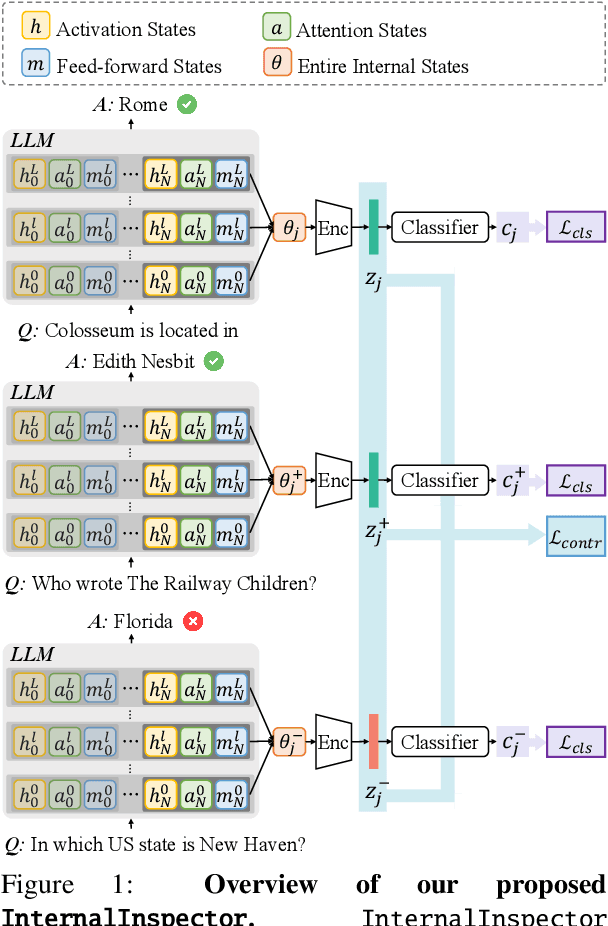
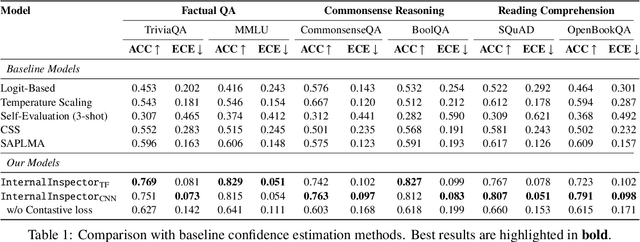
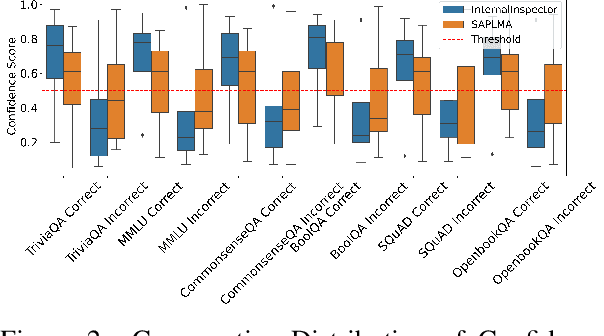
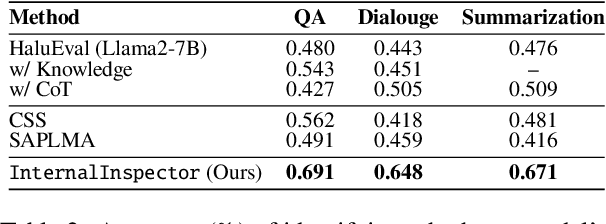
Abstract:Despite their vast capabilities, Large Language Models (LLMs) often struggle with generating reliable outputs, frequently producing high-confidence inaccuracies known as hallucinations. Addressing this challenge, our research introduces InternalInspector, a novel framework designed to enhance confidence estimation in LLMs by leveraging contrastive learning on internal states including attention states, feed-forward states, and activation states of all layers. Unlike existing methods that primarily focus on the final activation state, InternalInspector conducts a comprehensive analysis across all internal states of every layer to accurately identify both correct and incorrect prediction processes. By benchmarking InternalInspector against existing confidence estimation methods across various natural language understanding and generation tasks, including factual question answering, commonsense reasoning, and reading comprehension, InternalInspector achieves significantly higher accuracy in aligning the estimated confidence scores with the correctness of the LLM's predictions and lower calibration error. Furthermore, InternalInspector excels at HaluEval, a hallucination detection benchmark, outperforming other internal-based confidence estimation methods in this task.
 Add to Chrome
Add to Chrome Add to Firefox
Add to Firefox Add to Edge
Add to Edge